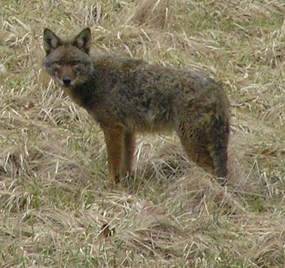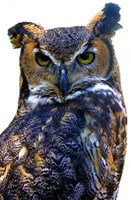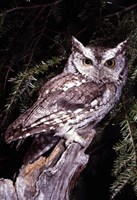
COURTESY, METRO PARKS, SERVING SUMMIT COUNTY Winter Coyotes Look for a slender animal very similar to a medium-sized dog with an elongated snout and a distinctive, bushy, black-tipped tail. Coyotes are generally gray, but may appear very blonde in color with reddish streaking to nearly jet-black. They stand one to two feet tall at shoulder, are three to four feet long, and weigh 25 to 45 pounds. Females are smaller. Coyotes jump around with tails carried down at a 45-degree angle, and generally step in a straight path. In contrast, dogs run with their tails up and tend to meander, often with distinctive overlapping tracks. Typically, coyotes are afraid of humans and run away from them. Treat them with respect by observing them at a distance. Please do not approach them. First recorded in Ohio in 1919, they now reside in all of Ohio’s 88 counties. For more information see Coexisting with Coyotes site bulletin. 
COURTESY ODNR Listen at dawn for nesting great horned owls (Bubo virginianus) calling from the Kendall Hills and along the Towpath, near the Beaver Marsh. They have a large repertoire of sounds: deep booming hoots, shrill shrieks, growling barks, coos, and beak snapping. Male voices are lower-pitched. Female voices rise in pitch at the end of the call. Great horned owls can also give calls as ventriloquists. 
COURTESY ODNR Watch for the return of the unusual northern shrike (Lanius excubitor) in the thickets surrounding the Jaite Mill site south of Red Lock Trailhead on the Towpath Trail, along the Buckeye trail, and other nearby trails. The northern shrike kills more prey than it can immediately eat. It stores food for later eating by impaling the prey on a thorn or wedging it in a forked twig. It eats small vertebrates, small birds, and large insects. Both males and females sing throughout year, but the male is especially expressive in late winter and early spring. Throughout December, look for wintering golden-crown kinglets and red-breasted nuthatches in the evergreens along the Tree Farm Trail.
|
Last updated: December 21, 2017
